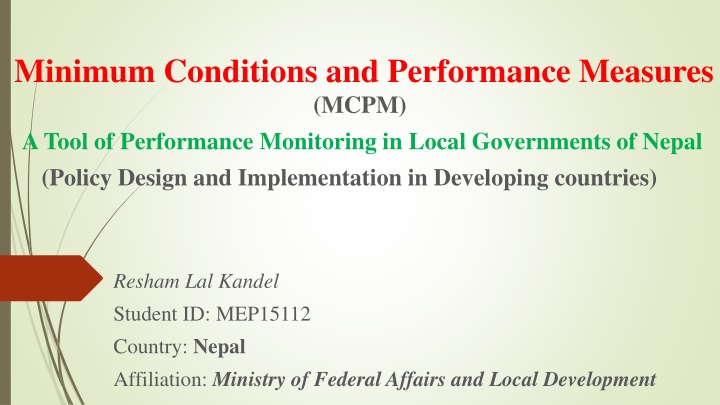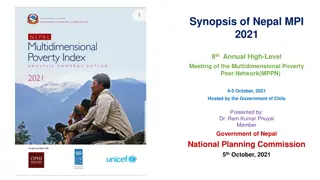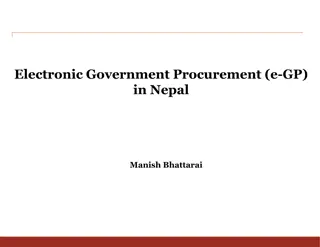Performance Monitoring with MCPM in Nepal's Local Governments
Monitoring the performance of local governments in Nepal involves assessing the existing situation, issues, and efforts towards decentralization. The Minimum Conditions and Performance Measures tool (MCPM) provides a framework for evaluation, highlighting the autonomous decision-making of local bodies, challenges in accountability, and the need for alignment in local investments.
Download Presentation

Please find below an Image/Link to download the presentation.
The content on the website is provided AS IS for your information and personal use only. It may not be sold, licensed, or shared on other websites without obtaining consent from the author.If you encounter any issues during the download, it is possible that the publisher has removed the file from their server.
You are allowed to download the files provided on this website for personal or commercial use, subject to the condition that they are used lawfully. All files are the property of their respective owners.
The content on the website is provided AS IS for your information and personal use only. It may not be sold, licensed, or shared on other websites without obtaining consent from the author.
E N D
Presentation Transcript
Minimum Conditions and Performance Measures (MCPM) A Tool of Performance Monitoring in Local Governments of Nepal (Policy Design and Implementation in Developing countries) Resham Lal Kandel Student ID: MEP15112 Country: Nepal Affiliation: Ministry of Federal Affairs and Local Development
Outline Overview of governance system in Nepal Overview of the Performance of LBs Existing situation, and issues on the Performance of LBs Learning & Development MCPM, its initiation and mainstreaming. Future prospective
Political divisions 7 Provinces, 75 Districts, 206 Municipalities & 3276 VDCs
Overview of Governance System in Nepal President P oli c y M a ki n g I m pl e m e nt at io n Other constitutional Bodies Executive Body Judiciary Parliament In Council of Ministers Transition al Phase of Unitary and Federal Govern ment NPC Ministries DDCs Departments Regional Offices District Offices Municipalities VDCs Service Centers NPC- National Planning Commission DDCs- District Development Committees VDCs-Village Development Committees
Efforts towards Decentralization in Nepal Commitment in Decentralization and about 50 years experience. Fundamental principles of local governance system Local self-governance, and Principle of devolution Local Self-Governance Act (LSGA), 1999 and its Regulation 2000.
Overview of the Performance of Local Bodies (LBs) Existing Situation of local governance LBs are autonomous on functional and financial decision making and implement their priorities. There is growing trend of responsibilities as well as source of funding. The new local self-governance act was enacted and elected LBs were working. But many LBs were not accountable according to the spirit of decentralization.
Overview of the Performance of LBs The central political will power remained weak. Some local leaders were comparatively motivated, but there was no uniform working environment. Planning and Implementation used to be delayed. Alignment of local investment was difficult. No more local elections were held after 2002. Control from center was almost impossible because of the issue of autonomy.
Issues on the Performance of LBs Improvements on local public services and establishing an accountable LBs. Introduce Performance Based Grant System. Start strong and effective tools of monitoring in the LBs.
Selected policy issues How the LBs could be monitored with consideration of the principle of local autonomy and make them accountable responsibilities. Introduce Minimum Conditions and performance Measures (MCPM) to monitor the performance of Local Governments. for their
What is MCPM ? A monitoring/evaluation tool to assess the performance of LBs. Indicator based assessment related to the duties and responsibilities of LBs based on legal provision. Two sets of indicators: (1)Minimum Conditions (MC)- Threshold criteria for the LBs. LB has to comply with the MCs if it is to be eligible to receive additional grants from the central government. Indicators for MCs are statutory requirements of LBs as provisioned in the LSGA 1999 and associated acts, rules, regulations and directives. Indicators for MCs are core functional areas of LBs such as planning and budgeting, financial management, functioning of various committees, transparency etc.
(1) MC indicators VDC indicators Annual Budget and program approval S.N. 1 DDC indicators Annual Budget and program approval Municipality indicators Annual Budget and program approval 2 Annual progress appraisal Annual progress appraisal Annual progress appraisal 3 Annual and quarterly progress report Grant utilization and accounting Final audit Annual and quarterly progress report 4 Internal audit and VDCs final audit Account operation of Municipality Fund 5 Account operation of District Development Fund Information and record management Final audit and record of irregularities Inventory management Tax and record of internal revenue source Audit and irregularity rectification 6 Social security program 7 Personnel management Assets management 8 Inventory management Building construction and design approval Publication of revenue and expenditure details and tax rate Personnel management 9 Personnel management 10
(2) Performance Measures (PM) PMs provide a range of score in different functional areas that help to assess the service delivery capacity and efficiency. LBs annual grant will depend on the scores achieved in PMs. These indicators direct the LBs to monitor its own function, to improve internal working capacity and to compare its activities with other LBs. A kind of third party monitoring and bench marking.
(2) Performance indicators Thematic areas Remarks DDC Planning and Budget Management Resource mobilization and financial management Budget release and program implementation Monitoring, Assessment Communication and Transparency Organization management and work responsibility Thematic areas-5 Total number of indicators-46 Municip ality Local governance Financial resource mobilization and management Plan and program management Organization and HRD Urban basic resource management Formulation of participatory village development program, Target group program Release and expenditure status Publication of income and expenditure statement Implementation of social security program Personal record database, VDC profile Citizen charter, Public audit, public hearing Internal resource management Thematic areas-5 Total number of indicators-40 VDC Thematic areas-13 Total number of indicators-100
How MCPM works ? It affects the relations- Between Center and Local government. Local politicians and People. Local government units and their Clients. Source: LGCDP, 2010. P.19
Assessment Method Assessment will be done on the set indicators For MC, only 2 option Yes or No For PM, There is total 100 marks. Free License Experts (Evaluators) Reporting to LBFC, MoFALD and MoF Appeal to LBFC The result is used to allocate the grants
Criteria for Additional Grants Performance rating and conditions 3 topmost DDCs/Municipalities 1 top VDC in each district S.N. 1 Reward/ sanction 20% addition in grant Staff incentives First DDC/ Municipality NPR 300 thousand Second DDC/ Municipality-NPR 250 thousand Third DDC/Municipality- 200 thousand NPR 125 thousand for DDCs & Municipalities NPR 100 thousand DDCs & Municipalities 2 Top 25% DDCs/ Municipalities/VDCs (First category) Second top 25% DDCs/Municipalities/VDCs (Second category) 15% addition in grant 3 10% addition in grant 4 Third 25% DDCs /Municipalities/VDCs ( Third category) 10% deduction in grant 5 Last 25% DDCs/Municipalities/VDCs (Lowest category) 15% deduction in grant 6 MC met but failed in PM (DDCs/Municipalities/VDCs) 20% deduction in grant 7 MC not met (DDCs/Municipalities/VDCs) Lose all formula based grant Note- In case of VDCs, DDC makes decisions
Why this System is Sustaining? The results of MCPM are linked with grant of LBs. Provision of prize/rewards. Resham Kandel,LDO, Dolakha - Awarded as second best performing DDC
Effect of this system: How the performance status changed DDCs-District Development Committees
How was this system initiated? Learning from abroad !!! Supported by (UNCDF) Uganda-Piloting 1997, full fledge 2003, Kenya & Mali-2001, Tanzania-2004, Bangladesh- piloting 2003, full fledge 2007, Indonesia,& Pakistan- 2005, Ghana-2008 The concept has been transferred from developed countries Lessons from Uganda (MCPM) and Philippines (LGPMS) were in center. Who was the Leader? Team effort - Bureaucratic Team within LBs, Forum of local leaders Relation with Stakeholders & Commitment in Implementation Support from Development Partners
How the system mainstreamed? The first stage Piloting in 20 districts in 2004 - DFDP districts The result was used to allocate unconditional (block) grant and some project specific grants (e.g. LGCDP funding) Second Stage Remaining 55 districts in 2006 To assure the trust (validity and reliability) of assessment process and result, quality assurance mechanism was developed. Replication of learning. Continuation of Implementation and DP s trust.
How the system addressed in Government Policy ? After seeing positive outcomes (in improving service delivery, planning and monitoring culture, spending capacity, record keeping and so on), Government formally accepted this system from FY 2006/07 and aligned in National System. Case (how does this system affect?): Kathmandu Metropolitan City failed in FY 2008/09 in MC/PM. This triggered the local politicians who questioned the staff why it happened. Then, the things started improving.
Components for sustaining the system This system is legalized by LSGA, 1999 and its regulation 2000. It is accepted as a part of regular government function and resource allocation Support from DPs. Local Bodies Fiscal Commission-LBFC (independent body) is assigned to execute the assessment process Linkage with financial incentives and penalties Ownership: Lead by central govt. agency Fully accepted by LGs
Issue for further improvement Improvement of Indicators (process based indicators to outcome based indicators), Linking the results to other governance indicators.
Conclusion Team effort and co-ordination between stakeholders is one important aspect of its success Commitment in implementation from government is another factor. (Government has taken lead role) Keys of success Simplicity of assessment manual, Quality assurance, Assessment by third party (Team composition: local governance expert and financial management expert), and Transparent indicators & process, and appeal system.
References: Local Bodies Fiscal Commission (LBFC). (2015). An Analysis Reports of MCPM in Local Bodies of Nepal: Kathmandu. www.lbfc.gov.np Local Governance and Community Development Programme (LGCDP). (2010). Analysis of the minimum conditions and performance measurement (MC/PM system) in Nepal. Local Self Governance Act (LSGA). (1999). Local Self Governance Regulation (LSGR). (2000). United Nations Capital Development Fund (UNCDF). (2010). grant systems: Concept and international Performance-based experience.























